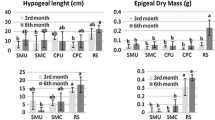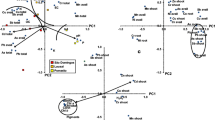Abstract
Highly metal-polluted (Pb, Cd, Zn) soil from a non-ferrous mine and smelter site in southern Poland, further referred to as “Waryński” soil, was used to test indigenous plant species for stabilization effectiveness of heavy metals in soils. Results of pilot investigations with commercially available cultivars of plant species showed that these cultivars could not grow on this highly polluted soil even with the application of soil amendments to stabilize the heavy metals. Based on these results, mesocosm and field experiments with an indigenous, metal-tolerant ecotype of Deschampsia cespitosa from the Waryñski site were carried out. The mesocosm experiment showed that applications of calcium phosphate (3.8% w/w) as a heavy metal-stabilizing amendment decreased Cd and Zn concentrations 2 and 3-fold respectively in leachates, whereas lead content was not significantly changed. This decrease in the concentration of heavy metals in leachates was correlated with a lower accumulation of Pb, Cd and Zn in the roots and shoots of D. cespitosa, ecotype Waryñski. In the field experiment, lower accumulations of Cd in roots and shoots and Zn in shoots in the amendment added plot were observed during the second year of investigations. In the first growing season, D. cespitosa plant cover in the amendment enriched mesocosms ranged from 95 to 100%, compared to 10% in mesocosms without calcium phosphate. In the second year of the experiment, in non-amendment enriched mesocosms D. cespitosa was substituted with Cardaminopsis arenosa(95% cover). C. arenosa is an undesirable species for phytostabilization, as it accumulates high amounts of zinc and cadmium in its shoots, even thought it provided better growth cover in not amended soils. However, in amended mesocosms, soil surface cover by D. cespitosa was still very high (90%). Similar results were obtained in field experiments. Addition of calcium phosphate to the soil also resulted in excellent D. cespitosa root system development when compared to soils without amendment. In amended mesocosms, high plant cover and root system development significantly decreased the volume of leachates and improved water retention. These results indicate that the use of D. cespitosa, ecotype Waryński in combination with calcium phosphate as a heavy metals immobilizing agent is sufficient to restore a dense vegetative cover to highly heavy metal-polluted soil.
Similar content being viewed by others
References
M G M Alam S Tokunaga T Maekawa (2001) ArticleTitleExtraction of arsenic in a synthetic arsenic-contaminated soil using phosphate Chemosphere 43 1035–1041 Occurrence Handle10.1016/S0045-6535(00)00205-8 Occurrence Handle1:CAS:528:DC%2BD3MXislGgs7g%3D Occurrence Handle11368218
A J M Baker C J Grant M H Martin S C Shaw J Whitebrook (1986) ArticleTitleInduction and loss of cadmium tolerance in Holcus lanatus L. and other grasses New Phytol. 102 575–587 Occurrence Handle1:CAS:528:DyaL28XktVWrur0%3D
W R Berti S D Cunningham (2000) Phytostabilization of metals I Raskin B D Ensley (Eds) Phytoremediation of Toxic Metals: using Plants to Clean up the Environment John Wiley & Sons, Inc. New York,USA 71–88
W R Berti S D Cunningham E M Cooper (1998) Case studies in the field – in-place inactivation and phytorestoration of Pb-contaminated sites J Vangronsveld S D Cunningham (Eds) Metal-contaminated Soils in situ Inactivation and Phytorestoration Springer-Verlag Berlin Heidelberg and R.G. Landes Company Georgetown, TX, U.S.A 235–248
J Boisson A Ruttens M Mench J Vangrosveld (1999) ArticleTitleEvaluation of hydroxyapatite as a metal immobilizing soil amendment for the remediation of polluted soils. Part 1. Influence of hydroxyapatite on metal exchangeability in soil, plant growth and plant metal accumulation Environ. Pollut. 104 225–233 Occurrence Handle10.1016/S0269-7491(98)00184-5 Occurrence Handle1:CAS:528:DyaK1MXovVOisg%3D%3D
N S Bolan D C Adriano P Duraisamy A Mani K Arulmozhiselvan (2003) ArticleTitleImmobilisation and phytoavailability of cadmium in variable charge soils. I. Effect of phosphate addition Plant Soil 250 83–94 Occurrence Handle10.1023/A:1022826014841 Occurrence Handle1:CAS:528:DC%2BD3sXit1CitL8%3D
S L Brown C L Henry R Chaney H Compton PS DeVolder (2003) ArticleTitleUsing municipal biosolids in combination with other residuals to restore metal-contaminated mining areas Plant Soil 249 203–215
X Cao L Q MaL M Chen S P Singh W G Harris (2003a) ArticleTitlePhosphate-induced metal immobilization in a contaminated site Environ Pollut. 122 19–28 Occurrence Handle10.1016/S0269-7491(02)00283-X Occurrence Handle1:CAS:528:DC%2BD3sXjtFyjsw%3D%3D
X Cao L Q Ma A Shiralipour (2003b) ArticleTitleEffect of compost and phosphate amendments on arsenic mobility in soils and arsenic uptake by the hyperaccumulator Pteris vittata L Environ. Pollut. 126 157–167 Occurrence Handle10.1016/S0269-7491(03)00208-2 Occurrence Handle1:CAS:528:DC%2BD3sXmsVGru7k%3D
S S Cilliers G J Bredenkamp (2000) ArticleTitleVegetation of road verges on an urbanisation gradient in Potchefstroom, South Africa Landscape Urban Plan. 46 217–239 Occurrence Handle10.1016/S0169-2046(99)00057-2
R M Cox T C Hutchinson (1980) ArticleTitleMultiple metal tolerances in the grass Deschampsia cespitosa (L.) Beauv. from the Sudbury smelting area New Phytol. 84 631–647 Occurrence Handle1:CAS:528:DyaL3MXlsVCqs7c%3D
S. Dushenkov Y. Kapulnik M. Blaylock B. Sorochinsky I Raskin B Ensley (1997) Phytoremediation: a novel approach to an old problem D L Wise (Eds) Global Environmental Biotechnology Elsevier Science B.V. Amsterdam 563–572
M Falkowski (1982) Polish grasses PWR i L Warsaw, Poland 564
Girondelot B, Bert V, Marseille F and Laboudigue A 2003 Restoration of a metal polluted dredged sediment deposit. In Phytoremediation Inventory. Eds. T Vanek and J-P Schwitzguebel. p. 68. Cost action 837 view, UOCHB AVCR.
W Geebelen D C Adriano D Lelie Particlevan der M Mench R Carleer H Clijsters J Vangronsveld (2003) ArticleTitleSelected bioavailability assays to test the efficacy of amendment-induced immobilization of lead in soils Plant Soil 249 217–228 Occurrence Handle10.1023/A:1022534524063 Occurrence Handle1:CAS:528:DC%2BD3sXhsVyrs7s%3D
D L Godbold W J Horst H Marschner J C Collins D A Thurman (1983) ArticleTitleRoot growth and Zn uptake by two ecotypes of Deschampsia cespitosa as affected by high Zn concentration Z Pflanzenphysiol. Bd. 112 315–324 Occurrence Handle1:CAS:528:DyaL2cXit1Slug%3D%3D
D L Godbold W J Horst J C Collins D A Thurman H Marschner (1984) ArticleTitleAccumulation of zinc and organic acids in roots of zinc tolerant and non-tolerant ecotypes of Deschampsia cespitosa J. Plant Physiol. 116 59–69 Occurrence Handle1:CAS:528:DyaL2cXlsVyhtr0%3D
S Gombert J Asta M R D Seaward (2004) ArticleTitleAssessment of lichen diversity by index of atmospheric purity (IAP), index of human impact (IHI) and other environmental factors in an urban area (Grenoble, southeast France) Sci. Total Environ. 324 183–199 Occurrence Handle10.1016/j.scitotenv.2003.10.036 Occurrence Handle1:CAS:528:DC%2BD2cXivFyht7k%3D Occurrence Handle15081705
S Hławiczka J Fudała (2003) Distribution of Cd, Pb and Hg emissions among sectors of economy in Poland and the emission assessment for the years 1990–2000 L Pawlowski M R Dudzinska A Pawlowski (Eds) Environmental Engineering Studies.Polish Research on the Way to EU Kluwer/Plenum New York 1–11
Houba V J G, Van der Lee, JJ, Novozamsky I 1995 Soil analysis procedures, other procedures (Soil and plant analysis, part 5b). Department of Soil Science and Plant Nutrition., p. 217. Wageningen Agricultural University.
R Janikowski M Korcz (2001) ArticleTitleEconomy and environment Zarządzanie Terenami Poprzemysłowymi 18 105
M S Johnson T McNeilly P D Putwain (1977) ArticleTitleRevegetation of metalliferous mine spoil contaminated by lead and zinc Environ. Pollut. 12 261–277 Occurrence Handle10.1016/0013-9327(77)90021-0 Occurrence Handle1:CAS:528:DyaE2sXhvVCju78%3D
A S Knox J Seaman D C Adriano G Pierzynski (2000) Chemophytostabilization of metals in contaminated soils D L Wise D J Trantolo E J Cichon H I Inyang U Stottmeister (Eds) Bioremediation of Contaminated Soils Marcel Dekker, Inc. New York, Basel 811–836
A S Knox J C Seaman M J Mench J Vangronsveld (2001) Remediation of metal- and radionuclides-contaminated soils by in situ stabilization techniques I K Iskandar (Eds) Environmental Restoration of Metal-contaminated Soils Lewis Publishers Boca Raton, London, New York, Washington, DC 21–60
S Kozłowski P Goliński Swedrzyński (1998) Grasses Wydawnictwo Literackie Parnas Inowrocław 185–188
Y M Li L Chaney (1998) Case studies in the field – industrial sites: phytostabilization of zinc smelter-contaminated sites: the Palmerton case J Vangronsveld S D Cunningham (Eds) Metal-contaminated Soils: in situ Inactivation and Phytorestoration Springer-Verlag Berlin Heidelberg and R.G. Landes Company Georgetown, TX, U.S.A 197–210
M Mench S Bussière J Boisson E Castaing J Vangronsveld A Ruttens T Koe ParticleDe P Bleeker A Assunção A Manceau (2003) ArticleTitleProgress in remediation and revegatation of the barren Jales gold mine spoil after in situ treatments Plant Soil 249 187–202 Occurrence Handle10.1023/A:1022566431272 Occurrence Handle1:CAS:528:DC%2BD3sXhsVyrs70%3D
S P McGrath F J Zhao E Lombi (2002) ArticleTitlePhytoremediation of metals, metalloids, and radionuclides Adv. Agron. 75 1–56 Occurrence Handle1:CAS:528:DC%2BD38XitVSjsLw%3D
P Migula K Binkowska (1993) ArticleTitleFeeding Strategies of grasshoppers (Chorthippus sp.) to heavy metal contaminated plants Sci. Total Environ. Suppl part 2 1071–1083
Mikłosz S 1966 Some features of D. cespitosa in aspect of habitat conditions. Ph.D thesis (in Polish).
Oliveira M R G, Noordvijk M, Gare S R, Brouwer G, Bona S, Mosca G and Hairiah K 2000 Auger sampling, ingrowth cores and pinboard methods. In Roots Methods. A Handbook. Eds. A L Smit, A G Bengough, C Engels, M van Noordwijk, S Pellerin and S C van de Geijn. pp. 186–191.
I R Phillips (1998) ArticleTitleUse of soil amendments to reduce nitrogen, phosphorus and heavy metal availability J. Soil Contam. 7 191–212 Occurrence Handle1:CAS:528:DyaK1cXisFylur0%3D
A J Pollard A J M Baker (1997) ArticleTitleDeterrence of herbivore by zinc hyperaccumulation in Thlaspi caerulescens (Brassicaceae) New Phytol. 135 655–658 Occurrence Handle10.1046/j.1469-8137.1997.00689.x Occurrence Handle1:CAS:528:DyaK2sXjtl2itbo%3D
A Rostański (1997) ArticleTitleVascular plants in areas contaminated with heavy metals Acta Biologica Silesiana T 30 IssueID47 56–85
L Rutkowski (1998) Vascular plants determination code for lowland Poland Wyd. Nauk. PWN Warszawa
D E Salt M Blaylock N P B A Kumar V Dushenkov B D Ensley I Chet I Raskin (1995) ArticleTitlePhytoremediation: a novel strategy for removal of toxic metals from the environment using plants Biotechnology 13 468–474 Occurrence Handle10.1038/nbt0595-468 Occurrence Handle1:CAS:528:DyaK2MXlsVynu7w%3D Occurrence Handle9634787
A Sas-Nowosielska R Kucharski E Małkowski M Pogrzeba J M Kuperberg K Kryński (2004) ArticleTitlePhytoextraction crop disposal – an unsolved problem Environ. Pollut. 128 373–379 Occurrence Handle10.1016/j.envpol.2003.09.012 Occurrence Handle1:CAS:528:DC%2BD2cXjtFarsQ%3D%3D Occurrence Handle14720479
R A H Smith A D Bradshaw (1979) ArticleTitleThe use of metal tolerant populations for reclamation of metalliferous wastes J. Appl. Ecol. 16 595–612 Occurrence Handle1:CAS:528:DyaL3cXktVKnsg%3D%3D
Stuczyński T I, Pistelok F, Siebielec G, Kukla H, Daniels W, Chaney R and Pantuck K 2000 Biological aspects of metal waste reclamation with biosolids in Poland. In Proc Symposium on Mining, Forest and Land Restoration: The Successful Use of Residuals/Biosolids/Organic Matter for Reclamation Activities (Denver, CO, July 17–20, 2000). Rocky Mountain Water Environment Association, Denver, CO.
P Theodoratos N Papassiopi A Xenidis (2002) ArticleTitleEvaluation of monobasic calcium phosphate for the immobilization of heavy metals in contaminated soils from Lavrion J Hazard Mater B94 135–146 Occurrence Handle10.1016/S0304-3894(02)00061-4
S Tokunaga T Hakuta (2002) ArticleTitleAcid washing and stabilization of an artificial arsenic-contaminated soil Chemosphere 46 31–38 Occurrence Handle10.1016/S0045-6535(01)00094-7 Occurrence Handle1:CAS:528:DC%2BD3MXptVShurs%3D Occurrence Handle11806530
G M Tordoff A J M Baker A J Willis (2000) ArticleTitleCurrent approaches to the revegetation and reclamation of metalliferrous mine wastes Chemosphere 41 219–228 Occurrence Handle10.1016/S0045-6535(99)00414-2 Occurrence Handle1:CAS:528:DC%2BD3cXivFKktr0%3D Occurrence Handle10819204
A P Turner (1994) The responses of plants to heavy metals S M Ross (Eds) Toxic Metals in Soil-Plant Systems John Wiley & Sons Ltd. Chichester, England 153–187
J Vangronsveld (1998) Case studies in the field- industrial sites: phytostabilization of zinc-smelter contaminated site: the Lommel-Maatheid Case J Vangronsveld S D Cunningham (Eds) Metal-contaminated Soils: in␣situ Inactivation and Phytorestoration Springer-Verlag, Berlin, Heidelberg and R.G. Landes Company Georgetown, TX, U.S.A 211–216
J Vangronsveld S D Cunningham (1998) Introduction to the concept J Vangronsveld S D Cunningham (Eds) Metal contaminated Soils: in situ Inactivation and Phytorestoration Springer-Verlag, Berlin, Heidelberg and R.G. Landes Company Georgetown, TX, U.S.A 1–15
J Vangronsveld F Van Assche H Clijsters (1995) ArticleTitleReclamation of a bare industrial area contaminated by non-ferrous metals: in situ metal immobilization and revegetation Environ. Pollut. 87 51–59 Occurrence Handle10.1016/S0269-7491(99)80007-4 Occurrence Handle1:CAS:528:DyaK2cXmsl2ktbk%3D Occurrence Handle15091607
B A K Von Frenckell-Insam T C Hutchinson (1993a) ArticleTitleNickel and zinc tolerance and co-tolerance in populations of Deschampsia cespitosa (L.) Beauv. subject to artificial selection New Phytol. 125 547–553 Occurrence Handle1:CAS:528:DyaK2cXis1Kis70%3D
B A K Von Frenckell-Insam T C Hutchinson (1993b) ArticleTitleOccurrence of heavy metal tolerance and co-tolerance in Deschampsia cespitosa (L.) Beauv. from European and Canadian populations New Phytol. 125 555–564 Occurrence Handle1:CAS:528:DyaK2cXis1Kis7o%3D
Author information
Authors and Affiliations
Corresponding author
Rights and permissions
About this article
Cite this article
Kucharski, R., Sas-Nowosielska, A., Małkowski, E. et al. The use of indigenous plant species and calcium phosphate for the stabilization of highly metal-polluted sites in southern Poland. Plant Soil 273, 291–305 (2005). https://doi.org/10.1007/s11104-004-8068-6
Received:
Accepted:
Issue Date:
DOI: https://doi.org/10.1007/s11104-004-8068-6




